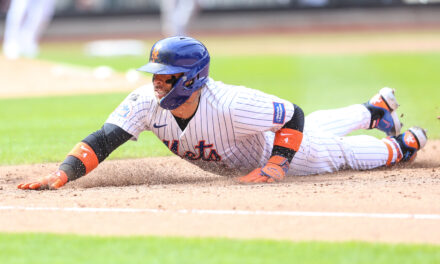With the current direction of the NY Mets, it seems there has been a lot of talk here about how much weight to put into Baseball America’s Prospect Rankings.
First, let me explain what BA actually does with regards to these rankings to avoid any assumptions. From their own website,
“Our prospect ratings are based on our own research and conversations with scouts, managers, instructors, front-office personnel and others in the game. Obviously all of that input is very important, but we make the final determination about where players fit on our various lists. We pay the most attention to a player’s long-term potential, and his chances of reaching that potential. A pitcher who could be a No. 1 starter usually rates higher than a guy who’s seen as a No. 4 starter, for instance, even if the second player has performed better in the minors. Others who rate prospects often pay more attention to a player’s present value—what he can do for an organization right away. That’s why even players who haven’t lived up to expectations yet can be so high in our prospect ratings. Based on their ability and potential, if they put it all together they could be major league stars. Another thing to pay attention to is a player’s age. A 19-year-old who’s putting up decent numbers in Triple-A is much more impressive than a 22-year-old who’s tearing up a Class A league.”
Second, let me make it clear that I don’t know a single person who thinks everything written in Baseball America should be chiseled in stone and placed outside every minor league ballpark. At the end of the day, these players are still human beings. A lot can change for good or for bad in terms of their potential to reach the Major Leagues. I firmly believe there is a huge risk in projecting any minor league player’s ceiling.
For example, if you put a gun to my head, I’d say it’s more likely that Zach Wheeler becomes a late inning reliever rather than a dominant starter. But who knows? I actually am not a huge fan of stockpiling prospects, but I understand that given the financial situation and the lack of organizational depth, that now is the time to give it a try.
Baseball America gives us a general idea of what is going on in the bus leagues. Do I think that when Sandy Alderson was offering Beltran he used Baseball America as his basis for wanting Zach Wheeler? Absolutely not. However, I think BA helps us the fan understand maybe what is going on behind closed doors.
You often hear that the hardest thing to do in sports is to hit a baseball right? If that is true, then the 2nd hardest thing is probably making it to the big leagues, and predicting who can have a legitimate MLB career. I think sometimes people forget not only how hard it is to get to the big leagues, but how hard it is to keep a job there for even just a few years.
Often times it seems as though an angry Mets fan may place some of the blame on the publication. So I decided to do a little experiment without having any clue of what the results would end up looking like.
I took each National League’s Top 10 Rankings in 1997, then 1999-2007. The reason for skipping 1998 was, I spent too much time trying to find that list, and since MMO doesn’t pay me, I couldn’t subscribe on the longshot that the archive was saved. Every other year was documented, which is odd. I assumed 2007 was a fair stopping point since some of those players listed in 2008-today are likely still in the Minors or just starting out.
I then did a name recognition test. Basically, if I knew their name that means they had a recognizable career which to me is tough to predict as it is. To verify, I ensured they played enough games to be considered on this list.
So from 1999-2007, that is 90 slots per team. Then add in 1997, and you’ve got a pool of 100 slots.
Here are the results:
Arizona: 43 out of 100
Atlanta: 45 out of 100
Chicago: 26 out of 100
Cincinnati: 29 out of 100
Colorado: 43 out of 100
Florida: 40 out of 100
Houston: 32 out of 100
Los Angeles: 29 out of 100
Milwaukee: 25 out of 100
Philadelphia: 40 out of 100
Pittsburgh: 36 out of 100
San Diego: 29 out of 100
San Francisco: 27 out of 100
St. Louis: 26 out of 100
Washington (includes Montreal): 31 out of 100
NY Mets: 25 out of 100
The average NL team has had 32.8 slots filled out of 100 of players who have had a legitimate MLB career. The Mets, along with Milwaukee finish dead last in the NL with 25 each.
The Mets that made the cut were: Jay Payton, Terrence Long (2), Preston Wilson, Octavio Dotel (2), Timo Perez, Aaron Heilman (2), Jose Reyes (2), David Wright (3), Scott Kazmir (2), Lastings Milledge (3), Matt Lindstrom, Mike Jacobs, Carlos Gomez (2), Mike Pelfrey, and Jon Niese.
I’d say I was more than fair with this list, wouldn’t you?
For comparison sake here is the list for Milwaukee: Geoff Jenkins, Ronnie Belliard (2), Ben Sheets (2), Bill Hall, JJ Hardy (4), Prince Fielder (4), Corey Hart (4), Rickie Weeks (2), Ryan Braun (2), Yovani Gallardo (2), and Nelson Cruz.
Which list would you rather have?
For further comparison here lets quickly look at 2 of the top teams, Atlanta and Philadelphia who have a combined 85 of possible 200 spots filled with big leaguers.
Atlanta’s list of 45: Andruw Jones, Bruce Chen (2), Wes Helms (3), Jason Marquis (4), Ronnie Belliard, Odalis Perez , Rafael Furcal (2), Marcus Giles (3), Wilson Betemit (3), Matt Belisle (2), Adam Wainwright (4), Kelly Johnson (2), Jeff Francoeur (3), Adam LaRoche, Brian McCann (2), Jarrod Saltlamacchia (3), Elvis Andrus (2), Yunel Escobar (2), Joey Devine (2), Chuck James, and Matt Harrison.
Philadelphia’s list of 40: Scott Rolen, Marlon Anderson (3), Adam Eaton, Pat Burrell (2), Randy Wolf, Brett Myers (3), Jimmy Rollins (2), Derrick Turnbow, Ryan Madson (4), Chase Utley (3), Marlon Byrd (3), Carlos Silva, Gavin Floyd (3), Cole Hamels (4),
Ryan Howard (3), Michael Bourn (4), and JA Happ.
One extreme difference you may notice is that they both seemed to have several players listed in their Top 10 multiple times. Of the 21 players in Atlanta, 6 of them did NOT get on their Top 10 more than once. Of the 17 Phillies, 11 of them appeared more than once with several appearing 3 or even 4 times.
Of the 15 Mets, 8 of them appeared more than once. That’s 53% of Mets, and 71% of Braves. That raises a red flag that perhaps the Mets players are being rushed up, doesn’t it?
So rather than pass full blame on Baseball America for their record of Mets prospects, perhaps we need to look a little deeper. You have to assume a small percentage of success and failure is based on luck, right? Getting that out of the way, what else is there?
Maybe if we start to question why the Mets are seemingly the worst NL Team at turning so-called prospects into quality big leaguers, we’ll find a better road map to the future for this franchise, rather than blaming a list?
I doubt you’ll often hear Braves, Diamondback, Rockies, Marlins, or Phillies fans complain about the accuracy of the prospects listed with their team, is Baseball America just better at predicting their minor leaguers or are they doing something different that teams like the Mets, Brewers, and Giants should be looking more closely at?
Maybe it’s both, but based on these results, there is no way you can tell me it’s all Baseball America’s fault.














